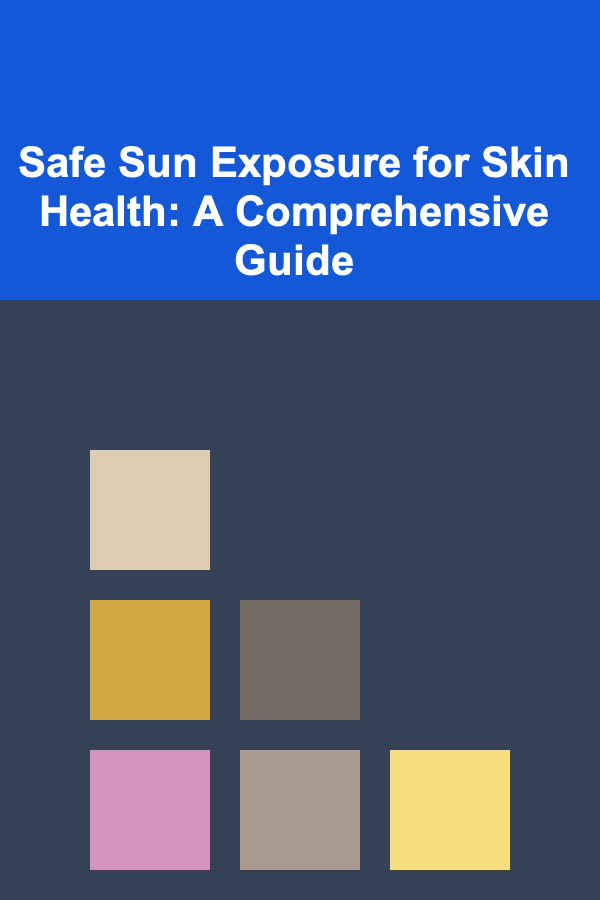
Safe Sun Exposure for Skin Health: A Comprehensive Guide
ebook include PDF & Audio bundle (Micro Guide)
$12.99$11.99
Limited Time Offer! Order within the next:

The sun, a vital source of life, provides us with warmth and light, and plays a crucial role in Vitamin D synthesis. However, prolonged and unprotected exposure to the sun's ultraviolet (UV) radiation can be detrimental to skin health, leading to premature aging, sunburn, and an increased risk of skin cancer. This guide provides a comprehensive overview of how to enjoy the sun's benefits while minimizing its risks, promoting both overall health and long-term skin well-being. We will delve into the science of UV radiation, explore the importance of Vitamin D, and outline practical strategies for safe and responsible sun exposure.
Understanding the Sun's Rays: UVA, UVB, and UVC
The sun emits a spectrum of electromagnetic radiation, but only UVA, UVB, and UVC rays reach the Earth's surface. Understanding the characteristics of each type of UV ray is essential for implementing effective sun protection measures.
- UVA (320-400 nm): UVA rays penetrate deep into the skin, reaching the dermis. They are primarily responsible for skin aging, causing wrinkles, sunspots, and loss of elasticity. UVA rays are present throughout the year, even on cloudy days, and can penetrate glass. They contribute to tanning, but this tanning is often associated with skin damage. UVA radiation also indirectly contributes to skin cancer development by damaging DNA.
- UVB (290-320 nm): UVB rays are shorter than UVA rays and primarily affect the epidermis, the outermost layer of the skin. They are the main cause of sunburn and play a significant role in the development of skin cancer. UVB intensity varies depending on the time of day, season, and location. They are strongest between 10 AM and 4 PM, during the summer months, and at higher altitudes. UVB radiation is also essential for Vitamin D synthesis in the skin.
- UVC (100-290 nm): UVC rays are the most dangerous type of UV radiation, but they are largely absorbed by the Earth's atmosphere and do not typically reach the surface. However, UVC radiation is used in certain industrial and medical applications, such as sterilization, and requires careful safety precautions.
The Benefits of Sunlight: Vitamin D Synthesis and Beyond
While excessive sun exposure poses risks, moderate sun exposure is crucial for optimal health, primarily due to Vitamin D synthesis. Vitamin D is a vital nutrient that plays a critical role in calcium absorption, bone health, immune function, and cell growth. A deficiency in Vitamin D can lead to various health problems, including osteoporosis, rickets (in children), and an increased risk of certain chronic diseases.
When UVB rays penetrate the skin, they convert 7-dehydrocholesterol (a precursor to cholesterol) into previtamin D3, which is then converted to Vitamin D3 (cholecalciferol). Vitamin D3 is transported to the liver and kidneys, where it is further metabolized into its active form, calcitriol. Calcitriol regulates calcium absorption in the intestines and helps maintain calcium and phosphate levels in the blood, which are essential for bone health.
Beyond Vitamin D synthesis, sunlight exposure may also offer other potential benefits, including:
- Improved Mood: Sunlight exposure can increase the production of serotonin, a neurotransmitter that plays a role in mood regulation. This may help alleviate symptoms of seasonal affective disorder (SAD) and improve overall well-being.
- Regulation of Circadian Rhythm: Sunlight helps regulate the body's natural sleep-wake cycle (circadian rhythm) by suppressing the production of melatonin, a hormone that promotes sleepiness.
- Potential benefits for certain skin conditions: Controlled sun exposure, under medical supervision, can be beneficial for treating certain skin conditions, such as psoriasis and eczema. However, this should only be done under the guidance of a dermatologist.
Determining Your Safe Sun Exposure Time
The amount of sun exposure needed for adequate Vitamin D synthesis varies depending on several factors, including:
- Skin Tone: Individuals with darker skin tones require longer sun exposure to produce the same amount of Vitamin D as individuals with lighter skin tones. Melanin, the pigment that gives skin its color, absorbs UV radiation and reduces the amount of UVB that reaches the deeper layers of the skin where Vitamin D synthesis occurs.
- Geographic Location: The intensity of UVB radiation varies depending on latitude. People living closer to the equator receive more UVB radiation than people living at higher latitudes.
- Time of Day and Season: UVB radiation is strongest between 10 AM and 4 PM, particularly during the summer months.
- Age: As we age, our skin's ability to produce Vitamin D declines.
- Health Conditions and Medications: Certain medical conditions and medications can affect Vitamin D synthesis.
A general guideline for Vitamin D production suggests that individuals with light skin tones may need as little as 10-15 minutes of sun exposure on their arms and legs, two to three times a week, during midday hours. Individuals with darker skin tones may require significantly longer exposure times, perhaps 30 minutes or more. However, it's crucial to emphasize that this is a general guideline and individual needs may vary. It's always best to consult with a healthcare professional to determine your specific Vitamin D requirements and safe sun exposure limits.
Furthermore, it's important to pay attention to your skin and avoid getting sunburned. Sunburn is a clear indication that you've been exposed to too much UV radiation and increases your risk of skin cancer.
Practical Strategies for Safe Sun Exposure
Protecting your skin from the harmful effects of the sun is essential for maintaining skin health and reducing the risk of skin cancer. Here are some practical strategies for safe sun exposure:
- Seek Shade: The simplest and most effective way to protect yourself from the sun is to seek shade, especially during the peak hours of 10 AM to 4 PM. Find trees, umbrellas, or other structures that can provide shade.
- Wear Protective Clothing: Cover your skin with tightly woven clothing. Long sleeves, long pants, and hats provide excellent protection from the sun. Choose fabrics with a UPF (Ultraviolet Protection Factor) rating for enhanced protection. Darker colors generally absorb more UV radiation than lighter colors.
- Use Sunscreen: Apply sunscreen liberally to all exposed skin, even on cloudy days. Choose a broad-spectrum sunscreen with an SPF (Sun Protection Factor) of 30 or higher. Broad-spectrum sunscreens protect against both UVA and UVB rays.
- SPF (Sun Protection Factor): SPF measures the sunscreen's ability to block UVB rays. For example, an SPF 30 sunscreen blocks about 97% of UVB rays, while an SPF 50 sunscreen blocks about 98%. While higher SPF numbers offer slightly more protection, no sunscreen can block 100% of UV rays.
- Broad Spectrum: Ensures protection against both UVA and UVB rays. UVA protection is often indicated by a "broad spectrum" label or a PA rating (PA+, PA++, PA+++, PA++++), which is commonly used in Asian sunscreens.
- Water Resistance: Choose a water-resistant sunscreen, especially if you're swimming or sweating. Water-resistant sunscreens are tested to remain effective for a certain period of time while in water (typically 40 or 80 minutes).
- Application: Apply sunscreen 15-30 minutes before sun exposure to allow it to bind to the skin. Use about 1 ounce (a shot glass full) of sunscreen to cover your entire body.
- Reapplication: Reapply sunscreen every two hours, or more frequently if you're swimming or sweating.
- Types of Sunscreen:
- Mineral Sunscreens (Physical Sunscreens): Contain mineral ingredients like zinc oxide and titanium dioxide. These minerals create a physical barrier that reflects UV rays. They are generally considered to be gentler on the skin and less likely to cause irritation.
- Chemical Sunscreens: Contain chemical filters that absorb UV rays. They are typically lighter in texture and easier to apply. Some chemical filters have raised concerns about potential hormone disruption, although the scientific evidence is still being investigated.
- Wear Sunglasses: Protect your eyes from UV radiation by wearing sunglasses that block 99-100% of UVA and UVB rays. Prolonged exposure to UV radiation can damage the eyes and increase the risk of cataracts and macular degeneration.
- Be Extra Careful Around Water, Sand, and Snow: These surfaces reflect UV radiation, increasing your exposure.
- Check the UV Index: The UV Index is a measure of the intensity of UV radiation from the sun. Check the UV Index forecast for your area and take appropriate precautions when the UV Index is high. You can find the UV Index on weather websites or apps.
- Avoid Tanning Beds: Tanning beds emit artificial UV radiation that is just as harmful as sunlight. Using tanning beds significantly increases your risk of skin cancer.
- Monitor Moles and Skin Changes: Regularly check your skin for any new moles or changes in existing moles. Consult a dermatologist if you notice any suspicious lesions. The ABCDEs of melanoma are a helpful guide:
- Asymmetry: One half of the mole does not match the other half.
- Border: The border of the mole is irregular, notched, or blurred.
- Color: The mole has uneven colors, such as black, brown, or tan.
- Diameter: The mole is larger than 6 millimeters (about the size of a pencil eraser).
- Evolving: The mole is changing in size, shape, or color.
- Consider Vitamin D Supplements: If you are unable to get sufficient Vitamin D from sun exposure or diet, consider taking a Vitamin D supplement. Consult with a healthcare professional to determine the appropriate dosage. Dietary sources of Vitamin D include fatty fish (salmon, tuna, mackerel), egg yolks, and fortified foods (milk, cereal).
Sunscreen: Choosing the Right Product and Using It Effectively
Selecting the right sunscreen and using it correctly are crucial for optimal sun protection. Here's a more detailed look at sunscreen:
- Understanding SPF: SPF stands for Sun Protection Factor. It measures the amount of time it would take for sun-exposed skin to redden with sunscreen compared to the amount of time it would take without sunscreen. For example, if you typically burn in 10 minutes without sunscreen, an SPF 30 sunscreen would theoretically allow you to stay in the sun for 30 times longer (300 minutes) without burning. However, this is a theoretical calculation and doesn't account for factors like sweating, swimming, and improper application.
- Broad-Spectrum Protection: Ensure that your sunscreen provides broad-spectrum protection, meaning it protects against both UVA and UVB rays. UVA rays contribute to skin aging and can also contribute to skin cancer, so it's essential to protect against them.
- Water Resistance: Choose a water-resistant sunscreen if you'll be swimming or sweating. Water-resistant sunscreens are tested to remain effective for a certain period of time while in water (typically 40 or 80 minutes). Remember to reapply sunscreen immediately after swimming or sweating heavily.
- Sunscreen Formulation: Sunscreens are available in various formulations, including lotions, creams, gels, sticks, and sprays. Choose a formulation that you find easy to apply and comfortable to wear. Lotions and creams are generally preferred for dry skin, while gels and sprays may be more suitable for oily skin.
- Mineral vs. Chemical Sunscreens:
- Mineral Sunscreens (Physical Sunscreens): Contain mineral ingredients like zinc oxide and titanium dioxide. These minerals create a physical barrier that reflects UV rays. They are generally considered to be gentler on the skin and less likely to cause irritation. They are also considered safer for coral reefs. Some mineral sunscreens can leave a white cast on the skin, but newer formulations are designed to minimize this effect.
- Chemical Sunscreens: Contain chemical filters that absorb UV rays. They are typically lighter in texture and easier to apply. Some chemical filters have raised concerns about potential hormone disruption and environmental impact, although the scientific evidence is still being investigated. Some jurisdictions have banned or restricted the use of certain chemical sunscreen ingredients.
- Proper Application: Apply sunscreen liberally to all exposed skin, including often-forgotten areas like the ears, neck, back of the hands, and tops of the feet. Use about 1 ounce (a shot glass full) of sunscreen to cover your entire body.
- Timing: Apply sunscreen 15-30 minutes before sun exposure to allow it to bind to the skin.
- Reapplication: Reapply sunscreen every two hours, or more frequently if you're swimming or sweating. Even water-resistant sunscreens need to be reapplied regularly.
- Expiration Date: Check the expiration date on your sunscreen. Expired sunscreen may not be as effective.
- Storage: Store sunscreen in a cool, dry place. Heat and humidity can degrade sunscreen ingredients.
Special Considerations
Certain individuals and situations require special consideration when it comes to sun protection:
- Children: Children are particularly vulnerable to the harmful effects of the sun because their skin is thinner and more sensitive. Keep babies under 6 months out of direct sunlight. For older children, use sunscreen, protective clothing, and shade.
- Pregnant Women: Pregnant women are more susceptible to melasma (dark patches on the skin) due to hormonal changes. Sun protection is especially important during pregnancy.
- Individuals with Certain Medical Conditions: Certain medical conditions, such as lupus and xeroderma pigmentosum, increase sensitivity to sunlight. Individuals with these conditions need to take extra precautions to protect themselves from the sun.
- Medications: Some medications, such as antibiotics, antidepressants, and diuretics, can increase sensitivity to sunlight. If you are taking any medications, check with your doctor or pharmacist to see if they can increase your risk of sunburn.
- High Altitude: UV radiation is more intense at higher altitudes. Take extra precautions when spending time in the mountains.
- Cloudy Days: UV radiation can penetrate clouds, so it's important to protect yourself from the sun even on cloudy days.
- Artificial UV Sources: Avoid tanning beds and other artificial sources of UV radiation.
The Importance of Regular Skin Cancer Screenings
Early detection is crucial for successful skin cancer treatment. Regularly examine your skin for any new moles or changes in existing moles. Consult a dermatologist if you notice any suspicious lesions. Professional skin exams by a dermatologist are recommended, especially for individuals with a family history of skin cancer or a high number of moles.
Conclusion: Balancing Sun Exposure for Health and Safety
Sunlight is essential for Vitamin D synthesis and overall well-being, but excessive and unprotected sun exposure can be detrimental to skin health. By understanding the risks and benefits of sun exposure and implementing practical sun protection strategies, you can enjoy the sun safely and maintain healthy, radiant skin for years to come. Remember to seek shade during peak hours, wear protective clothing, use sunscreen liberally, and monitor your skin for any signs of skin cancer. Consult with a healthcare professional or dermatologist to determine your individual needs and develop a personalized sun protection plan. Embracing sun-safe behaviors is an investment in your long-term health and well-being.

How to Keep Your Home's Chimney Clean and Safe
Read More
How to Turn Unused Spaces Into Valuable Storage Areas
Read More
How To Apply Highlighter for a Subtle Glow
Read More
Mastering Underpainting for a Natural Finish
Read More
Healthy Breakups, Healthy Futures: Moving On with Grace
Read More
How to Curate a Postcard Display for Your Home
Read MoreOther Products

How to Keep Your Home's Chimney Clean and Safe
Read More
How to Turn Unused Spaces Into Valuable Storage Areas
Read More
How To Apply Highlighter for a Subtle Glow
Read More
Mastering Underpainting for a Natural Finish
Read More
Healthy Breakups, Healthy Futures: Moving On with Grace
Read More